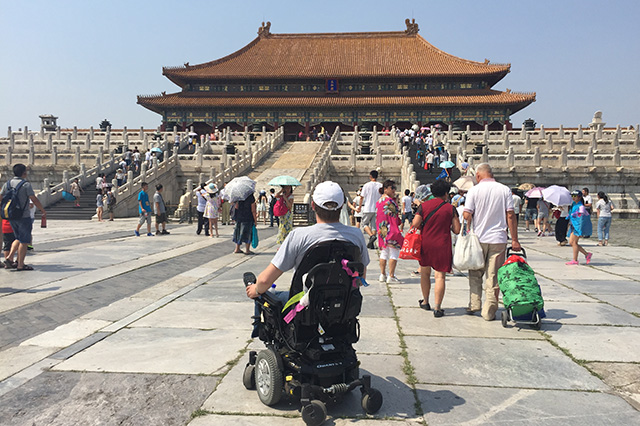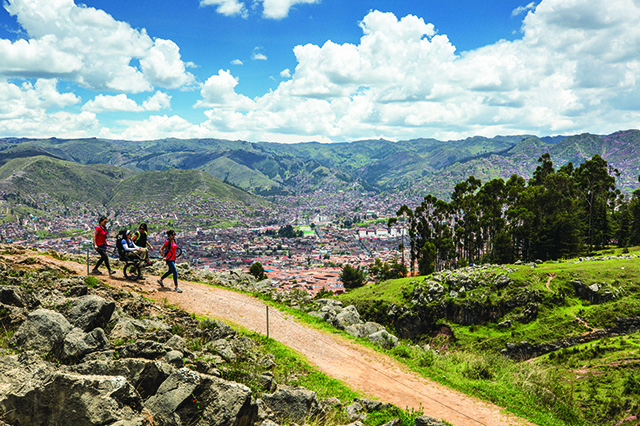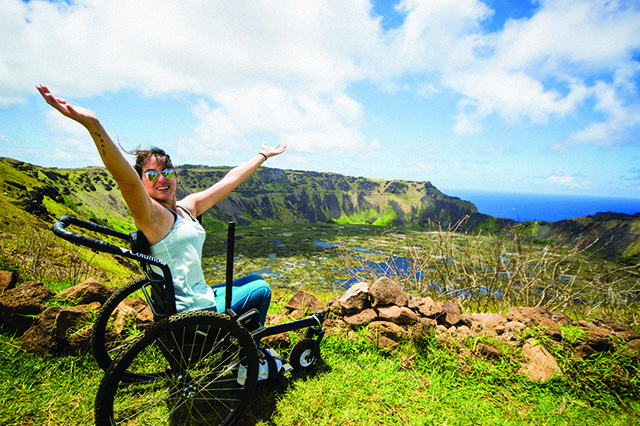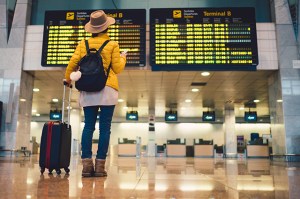After a devastating car crash and resulting fire made him a triple amputee, John Morris thought he might never travel again. But now, the Florida resident has flown more than a million miles and seen much of the world using his wheelchair.
“[Traveling with a disability] is always going to be a challenge, but not so much that it can’t be overcome,” Morris said. “The number one word that comes to mind is worthwhile.”
A desire to see his alma mater play in the Rose Bowl prompted his initial trip, from Orlando to Los Angeles, and inspired him to keep exploring. On his blog, wheelchairtravel.org, Morris rates U.S. and international destinations for accessibility and offers tips on how to navigate specific places while living with a disability.
“There’s an incredible demand for accessible travel,” he said.

A Surge in Need
It’s a category that’s on the rise as the travel industry has placed more emphasis in recent years on catering to those with disabilities. Travelers with disabilities make up a large segment of the population – an estimated 70 million people in the United States reported having a disability in 2022, according to the Centers for Disease Control and Prevention.
And they’re traveling. From 2022-2024, 25.6 million travelers with disabilities spent an estimated $50 billion on travel, down slightly from 2020, according to the most recent market study by the Open Doors Organization.
Laws like the Air Carrier Access Act – which makes it illegal for airlines to discriminate against passengers with disabilities and requires them to provide accommodations — and the Americans with Disabilities Act help make travel easier for those with disabilities; but naturally, unexpected difficulties can come up.
“You’d be surprised how many hotels are not ADA-compliant,” Morris said.
Opening Doors to All Travelers
The good news is that there are many travel agents, tour guides and other resources available to help navigate it all.
The travel company, Wheel the World, offers accessible adventure tours in locations including Easter Island, Chile and Oaxaca, Mexico. Last year, the company developed what is considered the first-ever wheelchair accessible tour of Machu Picchu in Peru.
The National Park Service has also made efforts to make its natural wonders more accessible. Many parks offer ASL interpreters for their ranger-led programs, and many trails, buildings and gift shops are wheelchair-accessible. The Grand Canyon has a scenic drive accessibility permit that allows travelers with limited mobility access to some areas normally closed to tourists.
And for four decades, Yosemite Deaf Services has provided ASL programming and assisted-listening devices to park visitors with hearing impairments.
The company Sage Traveling, founded by manual wheelchair user John Sage, specializes in research and travel in Europe and the Caribbean for people with limited mobility.
“It can be anything from slow walkers, (people with) MS, ALS, full-time wheelchair and scooter users and elderly travelers,” said marketing manager Sena Williams. “Our services are vetted to be 100% step- and curb-free, and all our routes include limited amounts of walking/strolling as well as vehicles with ramps/lifts.”

Travel Tips
Whether traveling with a physical or developmental disability, or with a friend or loved one who has one, here are some tips to help make the journey go smoothly.
Before the trip, consider what your realistic needs are, and make a plan based on those.
Travel almost always comes with unexpected challenges, but you can avoid some unnecessary frustration by putting in additional work before you leave. If you’re thinking about traveling alone, for instance, is it a better idea to ask a friend to come along in case you need help, or to hire a local guide who knows the area well? In some cases, such as with autistic children, doing a “dress rehearsal” practice run-through of what to expect on the trip can help reduce anxiety, recommends the advocacy group Autism Speaks.
Don’t overdo it.
If you know that you or your travel companion are likely to get physically or mentally tired, or overstimulated, schedule time to rest or participate in a more relaxing activity.
A hotel or attraction’s website might say that it is accessible, but what does that really mean?
Call places you plan to visit in advance to verify that they are in fact accessible, and if so, if those accommodations meet your specific requirements. If you need a shower seat in the bathroom, braille reading material in a museum, or a ramp into a historic house, for instance, make sure it’s available before you arrive.
Don’t be afraid to ask for help from strangers.
Morris recalls being in Beijing and having no choice but to ask a stranger to push his wheelchair to his hotel late at night because the battery had died and he was alone. It wasn’t his best travel moment, but he learned an important lesson. “The vast majority of people we will encounter are very good people who want to help if they see someone in need,” he said. “It’s in people’s nature to lend a hand, so get comfortable with asking for one.”
Autism-Friendly Travel Tips
Families with children on the autism spectrum face specific travel challenges: Crowded spaces, changes in routine, and unexpected noises and movements can be difficult for autistic travelers. We turned to Stacey Crowley, AAA Travel Business Operations Manager and certified autism travel professional, for some advice.
Don’t be afraid to reach out to airlines and airports.
You really would be surprised at how much they want to help you. I have worked with many autistic families and have been able to work with airports and airlines to do dry runs of going through security and getting on a plane and learning how the day of travel will work. They walk the members through different scenarios so they can help prepare their loved one for the unpredictability that travel comes with
Try to find a travel agent with special certifications.
AAA Northeast has quite a few travel advisors trained specially and specifically to know all the ins and out of accessible travel, from special needs travel to traveling with a person with autism.
Take some extra time to pre-plan as much as possible.
Most families that are traveling with a loved one with a disability, whether it be physical or intellectual, find that their travel experience runs smoother the more they pre-plan.
Do you have an accessible travel experience that you would like to share? Tell us about it in the comments.
Reach out to a AAA travel agent to learn more about accessible travel options today.
This article has been updated and republished from a previous version.
4 Thoughts on “All-Access Travel: Accessible Travel Destinations and Solutions”
Leave A Comment
Comments are subject to moderation and may or may not be published at the editor’s discretion. Only comments that are relevant to the article and add value to the Your AAA community will be considered. Comments may be edited for clarity and length.














I find it VERY difficult to learn accessibility info ahead of time for any destination. Just for an errand or for a planned outing. Calling usually does not help as those at the site think accessibility means one handicapped parking spot (usually not close to an entrance). No one seems to think through, in a practical way, how an individual needs to go from here to there. No regard to uneven/cracked surfaces. Having to travel further around to reach accessible area, signs not clear, restrooms not accessible. (Example: Quincy Market: they have accessible entrance but to get to/exit one must go ALL around the building! Not to mention cobblestones.) Then, in Boston, in general: sidewalks broken, blocked by construction, etc.
It is very tedious and not fun nor easy. A good part of the time, buttons to open doors do not work or are blocked. Many of the parks in Massachusetts have no real info on accessibility. Or information on how to get to the accessible point is not readily available. Information not online. No phone number or a phone that is not answered. And, as I said, if you need specific information on a path to gain the accessibility? No one seems to know. I find if VERY difficult and frustrating. (Consider if someone wants to visit these attractions alone; not bring a helper.)
Last summer my wife was able to get around only in a wheel chair due to a severely broken ankle on the mend. We had to take the Cross Sound Ferry from New London, CT to Orient Point, NY on our way to Hither Hills State Park Camp Ground. The ferry crew was very helpful in getting my wife from my car in the ferry waiting parking lot onto the ferry upper deck via the on board albeit tiny, elevator. They made sure I had enough time to get back to my car/travel trailer so I could drive it on the ferry before it left with my wife on board! Same drill three more times on that trip. A little nerve wracking, but it worked! While at the park I borrowed one of those “beach wheel chairs” with the big fat wheels but it was pretty hard to push even on the road. While doing so an 80 year old gentlemen (I’m 70) offered to help push and wouldn’t take no for an answer saying he was in great shape…and indeed he was. Quite a character we will never forget.
Hi James! That’s so great to hear. I’m glad you had such a good experience and that everyone was so helpful and accommodating!
-Dana 😉
I am an amputee with one leg missing. 2 years ago, shortly after my surgery, my wife and I decided to take a cruise to Hawaii. She planned the whole trip, including the flight to L.A. and the cruise with Princess. United Air Lines was terrific. They had special aisle wheelchairs to fit down the aisle of the plane. We reserved bulkhead seats so that I didn’t have to go all through the plane to get to a seat and I had plenty of room to maneuver my self into the seat. Princess set up a taxi to pick us up at the airport and transport us to the ship because I could not get up into the transport bus. My wife arranged through Scoot Around to rent a scooter for me to use on shipboard. She also reserved a wheelchair accessible stateroom on the ship. The room had plenty of room for my scooter and wheelchair. The shower was wheelchair accessible and they even provided little ramps to get over the door sill onto the balcony. The diningroom staff helped get me into a chair and took my scooter to park it away from the tables until after dinner when I needed it again. Then they returned it to me. For the return trip, we just reversed everything. I must say, United Air Lines and Princess Cruises were so accommodating and happy to do it! This was all before I got my prosthesis. I traveled for 16 days with only one leg.